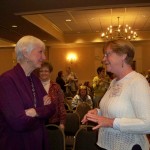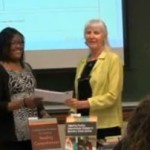Be the change you wish to see in the world…
Mohandas Gandhi
Barbara Stripling, President Elect of ALA, was the keynote speaker at a recent Massachusetts School Library Association Conference (March 2- 4, 2013). As a mentor, she encouraged those attending to “be the change,” to make a difference by changing one life at a time, and helping students raise their own dreams, skills, and dispositions of inquiry. Weaving the themes of collaborative relationships, decision making, and problem solving, she shared a vision of a vibrant model for student centered learning in 21st Century schools. Her passion and commitment to the field of librarianship and education is both inspirational and challenging. How can we live up to this ideal? I guess we just have to work harder at what we do best, so that we can be the change, too.
Two colleagues and I traveled from Vermont to Sturbridge, Massachusetts to participate in a three day event that allowed us to rub shoulders with Barbara Stripling, Richard Byrne, Pam Berger, and a host of authors, including Jack Gantos. We were excited to meet and talk to our compatriots from another New England state to compare notes about school library issues. We were also meeting some of our Twitter f riends for the first time face to face. Sitting in a large conference room, it was amusing to overhear people saying, “So there you are! It’s so wonderful to meet you in person after getting to know you through your blog or Twitter.” Having a chance to sit down and chat with the presenters between sessions, or during lunch and dinner provided a personal experience that you don’t have every day.
riends for the first time face to face. Sitting in a large conference room, it was amusing to overhear people saying, “So there you are! It’s so wonderful to meet you in person after getting to know you through your blog or Twitter.” Having a chance to sit down and chat with the presenters between sessions, or during lunch and dinner provided a personal experience that you don’t have every day.
As in other sections of the country, in New England and the Northeast, there are opportunities within reasonable driving distances for collaboration and mentoring at regional/state school library conferences and meetings. Many teacher librarians can’t afford to go to national conferences very often, or at all. Some have no financial support from their districts for professional development other that what is provided at the local level. State professional organizations play an important role in bringing national speakers and showcasing best practices within the field to a gathering of folks who come to share ideas, connections, and to make or renew friendships. PLNs now put practitioners in touch with others throughout the nation, and also provide connections within a geographical area, too. Social media and Twitter feeds allow everyone to communicate and collaborate across time and space. There are so many different ways to mentor and be mentored, in our fast paced world, but face to face collaboration is still a very powerful way to connect the dots.
Having returned from the conference with many new ideas and new relationships, I am already putting plans into action that will affect my teaching and learning. Coincidentally, once again, the current issue of Knowledge Quest : Mentoring Through Partnerships continues to look at collaboration, and the role of professional organizations is seen as a venue for mentoring. Melissa Johnston shares her conclusions from some research about technology leadership in Knowledge Quest (2013, 38), “Not only do professional organizations provide support for school librarians through relationships with other school librarians, but this research finds that professional growth opportunities from professional organization activities such as conferences and publications serve as enablers as well.” From my own experience, I can’t agree more! And as a final note, when I was doing a school visit last week, I went into the school library, and there inscribed on the wall was a familiar message: Be the change you wish to see in the world. I felt as if I had come full circle.
Barbara Stripling elected ALA president (2011). School Library Journal (May 4, 2012) http://www.schoollibraryjournal.com/slj/home/894466-312/barbara_stripling_elected_ala_president.html.csp
Johnston, M.P. (2013). The importance of professional organizations and mentoring for leadership. Knowledge Quest 41(4). http://www.ala.org/aasl/knowledgequest
Massachusetts School Library Association Conference: Lead & Learn (2013). http://maschoolibraries.org/content/view/1046/704/




